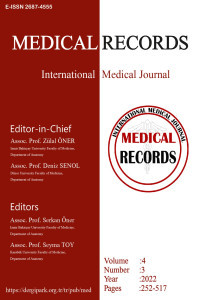Evaluation of Ventricular Arrhythmia Markers in Obstructive Sleep Apnea Syndrome Patients
Evaluation of Ventricular Arrhythmia Markers in Obstructive Sleep Apnea Syndrome Patients
Index of cardiac electrophysiological balance Obstructive sleep apnea syndrome, Ventricular arrhythmia,
___
- Mannarino MR, Di Filippo F, Pirro M. Obstructive sleep apnea syndrome. Eur J Intern Med. 2012;23:586-93.
- John RM, Tedrow UB, Koplan BA, et al. Ventricular arrhythmias and sudden cardiac death. Lancet. 2012;380:1520-9.
- Marinheiro R, Parreira L, Amador P, et al. Ventricular arrhythmias in patients with obstructive sleep apnea. Curr Cardiol Rev. 2019;15:64-74.
- Raghuram A, Clay R, Kumbam A, Tereshchenko LG, Khan A. A systematic review of the association between obstructive sleep apnea and ventricular arrhythmias. J Clin Sleep Med. 2014;10:1155-60.
- Yücetas SC, Kaya H, Kafadar S, et al. Evaluation of index of cardiac-electrophysiological balance in patients with subarachnoid hemorrhage. BMC Cardiovasc Disord. 2022;22:477.
- Kaya H, Suner A, Koparal M, et al. Evaluation of Tp-e interval, Tp-e/QT ratio and index of cardiac-electrophysiological balance in patients with tinnitus. BMC Cardiovasc Disord. 2021;21:415.
- Malhotra A, Ayappa I, Ayas N, et al. Metrics of sleep apnea severity: beyond the apnea-hypopnea index. Sleep. 2021;44:zsab030.
- Wall H, Smith C, Hubbard R. Body mass index and obstructive sleep apnoea in the UK: a cross-sectional study of the over-50s. Prim Care Respir J. 2012;21:371-6.
- Hesselbacher S, Subramanian S, Allen J, et al. Body mass index, gender, and ethnic variations alter the clinical implications of the epworth sleepiness scale in patients with suspected obstructive sleep apnea. Open Respir Med J. 2012;6:20-7.
- Gillis AM, Stoohs R, Guilleminault C. Changes in the QT interval during obstructive sleep apnea. Sleep. 1991;14:346-50.
- Barta K, Szabó Z, Kun C, et al. The effect of sleep apnea on QT interval, QT dispersion, and arrhythmias. Clin Cardiol. 2010;33:E35-9.
- Beach SR, Celano CM, Sugrue AM, et al. QT prolongation, torsades de pointes, and psychotropic medications: a 5-year update. Psychosomatics. 2018;59:105-22.
- Baumert M, Smith J, Catcheside P, et al. Variability of QT interval duration in obstructive sleep apnea: an indicator of disease severity. Sleep. 2008;31:959-66.
- Çiçek D, Lakadamyali H, Gökay S, et al. Effect of obstructive sleep apnea on heart rate, heart rate recovery and QTc and P-wave dispersion in newly diagnosed untreated patients. Am J Med Sci. 2012;344:180-5.
- Arias MA, Sánchez AM. Obstructive sleep apnea and its relationship to cardiac arrhythmias. J Cardiovasc Electrophysiol. 2007;18:1006-14.
- Franciosi S, Perry FKG, Roston TM, et al. The role of the autonomic nervous system in arrhythmias and sudden cardiac death. Auton Neurosci. 2017;205:1-11.
- Fukui S, Katoh H, Tsuzuki N, et al. Multivariate analysis of risk factors for QT prolongation following subarachnoid hemor- rhage. Crit Care. 2003;7:R7-12.
- Vanhecke TE, Franklin BA, Zalesin KC, et al. Cardiorespiratory fitness and obstructive sleep apnea syndrome in morbidly obese patients. Chest. 2008;134:539-45.
- Bisogni V, Pengo MF, Maiolino G, Rossi GP. The sympathetic nervous system and catecholamines metabolism in obstructive sleep apnoea. J Thorac Dis. 2016;8:243-54.
- Zhang M, Zhang W, Tan J, et al. Role of hypothyroidism in obstructive sleep apnea: a meta-analysis. Curr Med Res Opin. 2016;32:1059-64.
- Yayın Aralığı: Yılda 3 Sayı
- Başlangıç: 2019
- Yayıncı: Zülal ÖNER
Investigation of the Effect of Propolis on Penicillin Induced Epileptiform Activity in Rats
Anatomical Analysis of Foramen Magnum: A 3D Slicer CT Study
Nihal GÜRLEK ÇELİK, Burcu AKMAN
Osman KULA, Ahmet Onur ÇELİK, Burak GÜNAY
Effects of Electromagnetic Field (1.8/0.9 GHz) Exposure on Spleen in Rats
İlker KIZILOĞLU, Yeliz YILMAZ BOZOK, Levent TÜMKAYA, Dilek AKAKIN, Dila ŞENER AKÇORA
Effect of Folic Acid in Sepsis-induced Lung Damage in Rats
Guner YURTSEVER, Ejder Saylav BORA, Ebru EROĞLU, Yiğit UYANIKGİL, Mümin Alper ERDOĞAN, Oytun ERBAŞ
Prevalence, Number and Localization of Wormian Bones in Anatolian Adult Dry Skulls
Abdullah ORTADEVECİ, Serdar BABACAN
Zekiye İpek KATIRCI KIRMACI, Suat EREL
Kubilay İŞSEVER, Ali MUHTAROĞLU, Furkan Ali UYGUR, Muhammet Burak KAMBUROGLU
